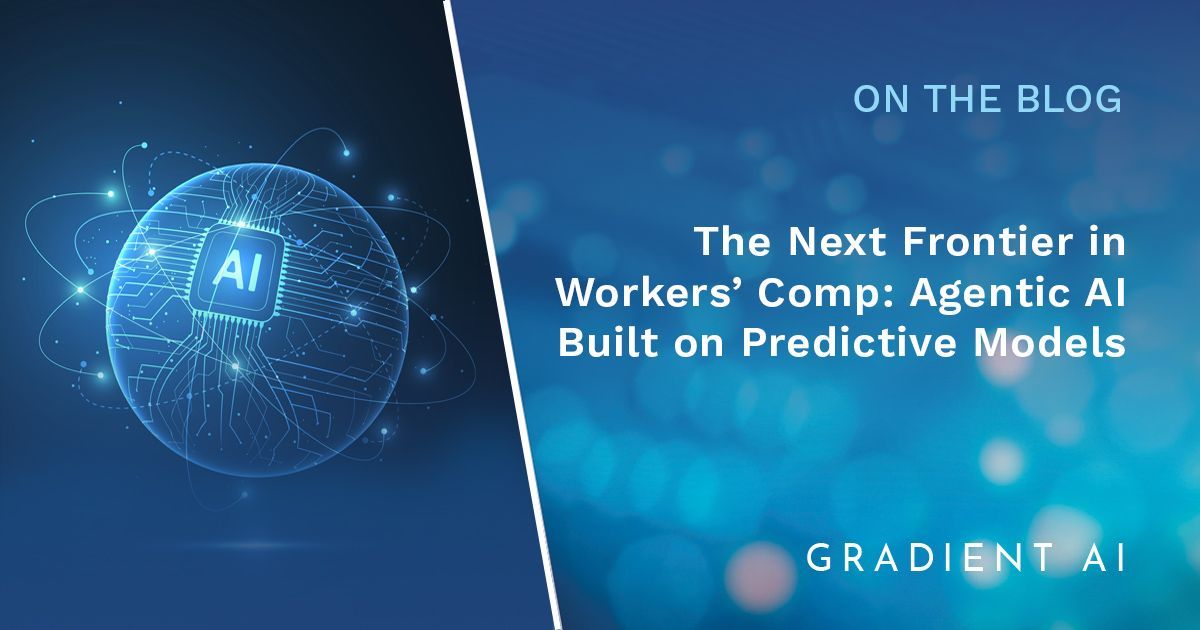The Next Frontier in Workers’ Comp: Agentic AI Built on Predictive Models
In Workers’ Compensation insurance, predictive models have been a powerful tool for years. They help insurers better understand risk, price policies more accurately, and intervene earlier in claims that could become more complex or costly.
But what comes next?
The answer is agentic AI. This technology moves beyond predictions and takes meaningful actions. In a market like Workers’ Comp, where accuracy and timing are critical, this shift could transform the way insurers support injured workers and manage claims.
What Are Predictive Models in Workers’ Comp Insurance?
At a basic level, predictive models are systems trained to analyze historical data and estimate what is likely to happen in the future. These systems don’t know the future, but they recognize patterns from the past that can help forecast outcomes.
With Workers’ Comp AI solutions like Gradient AI’s, predictive models help insurers answer questions like:
- How likely is it that a worker in a specific job will get injured?
- If an injury occurs, how long might recovery take?
- What interventions would help the injured worker recover?
These models use data from a variety of sources, including worker demographics, job descriptions, injury types, medical records, and treatment timelines. They help insurers understand how to price policies, manage risk, spot issues early on, and where to prioritize resources.
For instance, if a model shows that a certain type of injury often results in extended time away from work, the system can raise a flag. That gives the insurer a chance to step in early. Still, the decision to act often rests with a human.
What Is Agentic AI?
Agentic AI goes a step further. Instead of just identifying patterns or risks, it acts on them. It doesn’t just highlight that something might happen. It takes the next steps on behalf of the human insurance team member, often automatically and within predefined rules.
Think of the difference this way:
- A predictive model acts like a smart advisor. It provides insights and forecasts.
- Agentic AI behaves more like a reliable assistant. It acts based on those insights.
These models are not meant to replace people. They are designed to work in conjunction with them. Agentic AI can handle time-sensitive tasks, follow established workflows, and reduce the need for manual input. That allows adjusters to focus on the claims that require their expertise.
How Predictive Models Lead to Agentic AI
Agentic AI builds on the foundation of predictive models. The evolution from prediction to action typically happens in a few stages:
- Pattern recognition: Predictive models are trained to recognize patterns in historical claims data.
- Automation: Workflows are set up to respond to certain predictions, such as flagging a claim or assigning a risk score.
- Decision logic: Business rules are added so the workflows can make conditional choices and recommend steps.
- Autonomous action: The technology gains the ability to act on its own, such as triggering notifications, sending messages, or initiating follow-ups.
None of this eliminates the need for human review. What it does is to make sure that the most urgent or high-risk cases get the attention they need without delay.
A Practical Example in Workers’ Comp Insurance
Here’s how this might play out in the real world.
Example predictive model output: “This injured worker is at high risk of delayed recovery.”
That’s valuable information. But without further action, it may sit in a report or require someone to notice it manually.
With agentic AI:
- The claims technology platform flags the case in real time
- A case manager is alerted immediately
- A draft message is prepared for outreach
- Next steps are recommended, such as scheduling a follow-up or sharing return-to-work resources
This all happens shortly after the claim is filed or updated. It removes friction and ensures that action occurs when it can make the most impact.
Why It Matters
Workers’ Comp insurance involves real people and complex situations. Delays or missed signals can lead to longer recovery times, higher claim costs, and frustration for all involved. Predictive models help identify potential areas of concern. Then, agentic AI helps respond to them quickly and consistently.
Key benefits include:
- Earlier intervention: Claims with high risk can be addressed faster, improving outcomes and controlling costs.
- Greater consistency: Rules and logic are applied the same way every time, regardless of individual workloads or experience.
- Reduced manual work: Tasks such as flagging, routing, and messaging can be automated.
- More personalized care: Injured workers receive more timely support based on their specific needs and risk profiles.
Conclusion: What’s Next in Workers’ Comp?
For Workers’ Comp insurers, agentic AI is a logical next step. It brings together the predictive power of data with the ability to act on it immediately and intelligently.
Agentic AI is not about removing people from the process. It is about giving them better tools. It enables claims professionals to be more strategic. It ensures best practices are applied more reliably. And it provides injured workers with the timely attention they deserve.
Stay on top of AI trends by subscribing to Advanced Insights, the newsletter for strategies, ideas, and insights on AI in insurance. Delivered monthly to your inbox. Subscribe Now →


